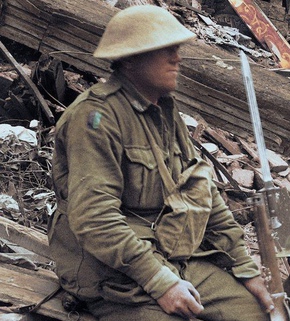
CULLEN, William Francis
| Service Number: | 1894 |
|---|---|
| Enlisted: | Not yet discovered |
| Last Rank: | Private |
| Last Unit: | 53rd Infantry Battalion |
| Born: | Waverley, New South Wales, Australia , December 1894 |
| Home Town: | Leichhardt, Leichhardt, New South Wales |
| Schooling: | Not yet discovered |
| Occupation: | Bread Carter |
| Died: | Wounds, Peronne, France, 3 September 1918 |
| Cemetery: |
Herbecourt British Cemetery Row B, Grave No.13. Australian War Memorial WW1, panel 157 |
| Memorials: | Australian War Memorial Roll of Honour |
World War 1 Service
| 14 Apr 1916: | Involvement Private, 1894, 53rd Infantry Battalion, --- :embarkation_roll: roll_number: '19' embarkation_place: Sydney embarkation_ship: HMAT Ceramic embarkation_ship_number: A40 public_note: '' | |
|---|---|---|
| 14 Apr 1916: | Embarked Private, 1894, 53rd Infantry Battalion, HMAT Ceramic, Sydney |
William’s story
William Cullen was born in Sydney in 1895, to Thomas and Martha Cullen. His father had been born in Ireland, emigrating to Australia in 1875. William went on to find employment in Sydney as a labourer, and married Martha Putney in 1893 before beginning a family that would grow to eight children. After serving 18 months with the senior cadets, in 1911 William became an apprentice in the boot trade. When war broke out in three years later, William was a 19-year-old bread carter and single, living with his parents in Leichhardt. William may have been keen to enlist right away, but at 5 foot 2 inches he was under the minimum height required. The following year, however, the press for more volunteers saw the minimum height dropped. William enlisted on the 25th of February 1916 and was soon sent to Bathurst where he joined reinforcements for the 53rd Battalion. He embarked from Sydney on the 23rd of June 1916 on board the troopship Barambah. During the eight-week voyage William was sick with the flu and was fined two days' pay for using insubordinate language when speaking to an officer. Arriving in England in August, William and his comrades underwent further training. At this point his younger brother, Thomas, joined him. They were sent to France in mid-November and joined the 53rd Battalion on the Somme. Known as the "Whale-Oil Guards" because of the polish applied to their helmets, the 53rd Battalion had formed in Egypt in February, before becoming battle-hardened at Fromelles. Through the long, cold winter of 1916 and 1917 William served alongside his comrades. Before long he fell ill with trench foot which put him out of action for a few months. Re-joining his unit in March 1917, he advanced to the Hindenburg Line where in May the bloody Second Battle of Bullecourt was fought. Later that year the 53rd Battalion was sent to the Ypres sector in Belgium. William endured another battle at Polygon Wood in September, before an impossible slog through the mud at Passchendaele. In the spring of 1918 the Germans launched their spring offensive.
Pushed back to the Somme, the Australians made a stand at Villers-Bretonneux where William was gassed on the 17th of April. After a recovery in England he returned to the battalion on the 2nd of August. Six days later the Australian Corps struck a blow at Amiens [forcing the Germans into headlong retreat. In the weeks that followed it drove the enemy back along the Somme, and at the end of August made a stand at Mont St. Quentin and Perone. Before dawn on the Ist of September the 53rd Battalion moved into position north-west of Perone. In drizzling rain it attacked, but immediately encountered enemy troops and dense barbed wire. As another unit broke into the moated town, the 53rd battled to seize Anvil Wood. It advanced into a cemetery but was pinned down by intense enemy fire from three sides. Late in the afternoon the men were ordered forward once more, but again, enemy fire stopped them cold. The 53rd Battalion suffered nearly 60 per cent casualties, with 252 men hit, including 51 killed. Younger brother Thomas was wounded in the leg, but survived the war.
On the 2nd of September, the 53rd Battalion held its position while other units advanced, clearing Perone of enemy troops. A photo taken that day shows five Australian soldiers in the ruins of the town - four men of the 54th Battalion, and William Cullen of the 53rd. He was likely still there the next day, despite his battalion having been relieved and pulled back to the western side of the river. On the 3rd of September William suffered multiple shrapnel wounds to his chest, left arm and thigh. He was taken to the 15th Field Ambulance at Herbecourt but was dead on arrival. His remains were buried at Herbecourt British Cemetery. He was 23 years old.
Submitted 4 September 2023 by John Baker









